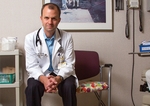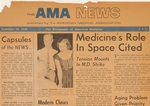business
How to maximize patient flow through the office
■ A column about keeping your practice in good health
Do patients arrive at your office and flow smoothly from one point to another while getting the care and services they need?
Or are patients, physicians and staffers frustrated by the way the office is run?
"Patient complaints and staff turnover and sometimes even physician turnover are signs that there is a problem," said Elizabeth Woodcock, principal of Woodcock & Associates, a physician management and consulting firm in Atlanta. "Nobody likes working in that kind of environment."
A survey by the Medical Group Management Assn. released Jan. 11 found practices that were financially healthier and designated as "better performers" were more likely than those that were not doing as well to say they paid close attention to patient flow. Although patient complaints and high staff turnover can indicate a problem, experts say patient flow is something nearly all practices need to think about. It is not an issue that completely goes away, and the situation can usually be improved.
"Can we make this a little bit better? The answer is always yes, and it's never a done deal," said L. Gordon Moore, MD, who has studied patient flow and is president of Ideal Medical Practices, a consulting firm in Seattle.
How to make it better will vary depending on the practice. Solutions may change from day to day. There are, however, common problems and several ways to carry out a patient flow evaluation.
Getting staff cooperation
The first step is to get staff buy-in that this is worth working on. Those who advise practices on patient flow suggest appealing to staffers' desire to leave the office on time and provide higher-quality care. Benefits of increased revenue and patient satisfaction should be spelled out.
"People are afraid of change," said Jamie Verkamp, managing partner of (e)Merge in Kansas City, Mo. "You need to explain why the change benefits them."
The next step is to assess how patients move through a practice. This may be as simple as a physician and other staff members walking through the entire process.
"Walk the walk of the patient from the front door to the checkout window," Dr. Moore said. "It doesn't take an operational engineer to find opportunities and begin to improve."
Practices may want to try timing patients as they move through the office. The times when patients arrive, complete check-in, wait in the reception, wait in the exam room, see a physician, check out and leave can be noted and analyzed.
"You need to measure it and see where what I call the 'puddles' to the patient flow are," said Thomas Weida, MD, a family physician and medical director of University Physician Group at Penn State Hershey Medical Center in Hershey, Pa.
Carrying out some form of evaluation may identify easier-to-fix problems such as out-of-date signage or issues with the office layout. Supplies or equipment may not be within easy reach, adding time to the process and creating more problems.
"If you're going to do something regularly, what you need should be in reach and never more than an arm's length away," Dr. Moore said.
But there may be issues that will take more work to address. For example, unnecessary steps may have accumulated over time and bog things down. For example, Dr. Moore consulted with a psychiatry practice that required staff to take 12 separate actions and walk 414 feet to make each patient appointment.
"There may be multiple steps in the process that can be streamlined," Dr. Moore said. "And you have to challenge your own assumptions about what is important."
The way patients are scheduled can affect patient flow. Ob-gyn Lynn Groome, MD, PhD, who runs a high-risk obstetrics clinic at Louisiana State University Health Sciences Center in Shreveport, sat down with his office staff to discuss patients' flow after they reported long waits in the reception area. It was determined that the slowdown was caused in part by staff booking all new patients, who take longer than established ones, on the same day. Spreading new patient appointments throughout the week helped address the issue.
The practice implemented several protocols to ensure the exam room was prepared for any procedures scheduled.
"It's all about anticipating where the problems are," said Dr. Groome, chair of obstetrics and gynecology at LSU Health Sciences Center in Shreveport.
Experts suggest paying attention to verbal communication with a patient. Have physicians and others at the practice been clear about what a patient needs to do next?
"Patients don't always know whether the visit is over or not and sit there in the exam room thinking somebody is going to tell me what happens next," said Meryl Luallin, a partner in Sullivan Luallin, a medical consulting firm in San Diego. "The medical assistant tries to room the next patient, and the first patient is still in the exam room. "
Whatever problems and solutions are identified, experts advise against addressing everything at once. Slow change tends to work better, and buy-in from staff will probably become greater as results become apparent. This will allow the practice to assess whether changes are having the intended effect.
"As soon as staffers saw what we were doing, they thought it was great," Dr. Groome said. "They saw improvement and came up with a lot of useful suggestions. That helped a lot."












